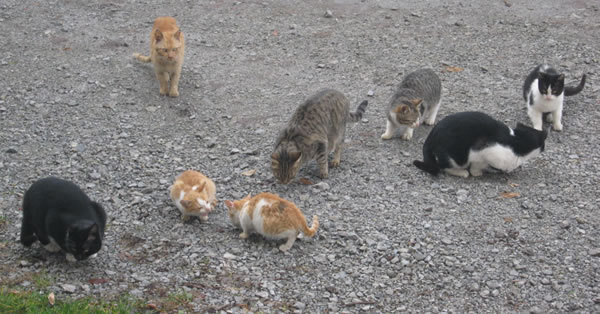Auckland Council is currently consulting on its Pest Management Plan. Under this plan there is a way wandering cats could be managed, but the Council will only act if people stand up and ask for it.
Why cats currently slip through the net
Most of the species that harm our native species are managed in some way. Possums, stoats and rats are trapped or poisoned. Dogs are managed, and if they are found wandering without identification are rehomed humanely euthanised.
Currently feral cats are defined as a pest in Auckland’s pest management plan. Unfortunately in populated areas (like most of the Auckland isthmus) there is no way to enforce this because there is no way to tell if a cat is a feral, stray or pet cat. So generally speaking cats don’t get managed anywhere near people’s houses.
This is a massive issue – in many sensitive wildlife areas locals are trapping rats and stoats, only to see precious native wildlife falling prey to cats. It wastes all their hard effort in trying to save our native species and restore these important areas.
How Auckland Council could manage cats
To manage cats, the Council needs to be able to identify if a cat is owned, either with a microchip or collar.
Under the pest management plan, Auckland Council could define a feral cat as a cat without a microchip or other identifier (such as a collar or harness). This definition would only apply in sensitive wildlife areas.
Any cats found wandering in sensitive wildlife areas could be checked for identification. If they have identification they could be returned to their owners, and if not, they could be rehomed or humanely euthanised.
Sensitive Wildlife Areas
As we have seen on the #kakacam, right now native birds are nesting and fledging all over the country. This is when they are at their most vulnerable to wandering cats and dogs. Dogs are managed already, so they shouldn’t be wandering off their leads in sensitive wildlife areas. However, there is no way to stop cats from wandering in these areas, particularly when they are near houses.
You have the ability to suggest areas to be deemed sensitive wildlife areas as part of the pest management plan.
Examples of sensitive wildlife areas might be the Waitakere and Hunua Ranges where endangered kokako are breeding, and even places like the Te Atatu Peninsula, where the threatened fernbird lives.
But my cat isn’t a pest!
Getting your cat microchipped would also help keep it safe. Not only would it ensure that it isn’t mistaken for a feral cat, but microchips generally reduce your cat’s chances of getting lost. After the Christchurch earthquake, more than 80% of the lost cats with microchips found their way home, whereas only 15% of the cats without microchips did the same. Having a system of microchipping should also prevent a repeat of the pet cat that was killed when found behind the predator proof fence in Shakespear Regional Park.
People are constantly surprised to find how far their cats can wander – up to 2.4km in rural areas and around half that on the urban fringe. So if you live any where near a wildlife area then your cat could potentially be wandering that far. Cats also only bring home 1 in 5 things that they kill on average, so just because you haven’t seen your cat with a native bird or lizard doesn’t mean they don’t kill them.
We’ve made it easy to submit online
To make your life easy we have only included the questions that are relevant to cats. You can make a full submission here
[gravityform id=”4″ title=”false” description=”true”]
